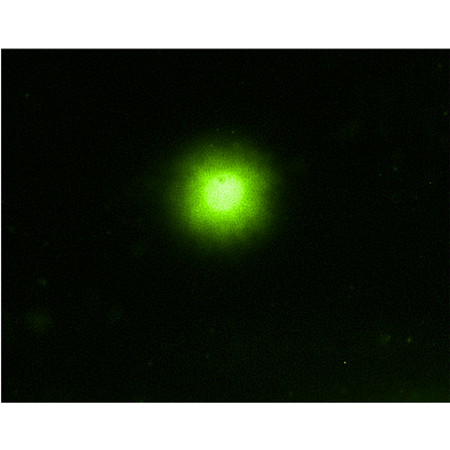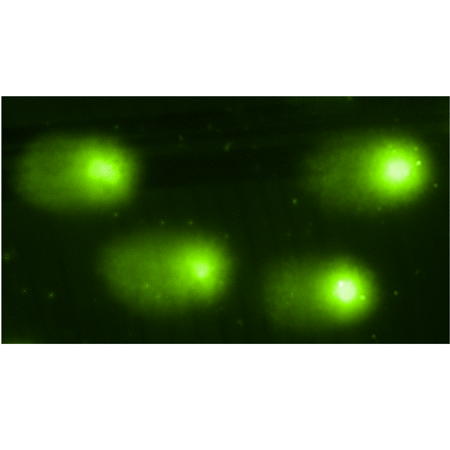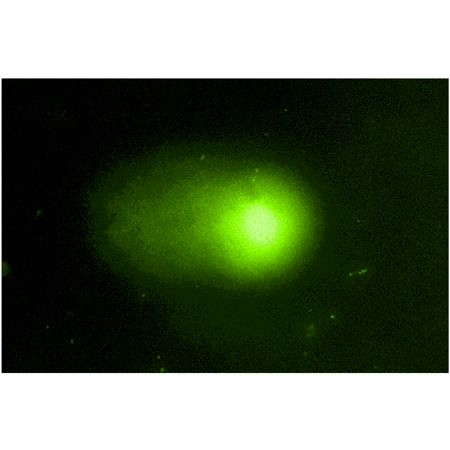Fast and simple electrophoresis method to measure DNA fragmentation
- Ready-to-use Comet Slides allow direct application of sample without pretreatment
- Shorter assay time allows for higher throughput sample analysis
- Hydrophobic barrier allows sample treatment with DNA repair enzymes
- Unique nucleic acid stain provides improved sensitivity for DNA visualization compared to ethidium bromide
Exposure of cells to oxidative and environmental stresses frequently results in the breakdown or oxidation of genomic DNA. Assays to evaluate the integrity of genomic DNA, or to assess the presence of oxidized DNA are frequently used as a means of verifying the onset of apoptosis or DNA damage. The Comet SCGE Assay measures DNA damage by fluorescently detecting the integrity of DNA liberated from cells embedded in low melting point agarose. Upon electrophoresis, fragmented DNA produces a characteristic “comet” shaped tail as small DNA fragments migrate in the gel more rapidly than in-tact genomic DNA. The Comet SCGE Assay is a fast and simple electrophoresis method to detect and quantitate DNA fragmentation in cells associated with DNA damage and apoptosis. A unique nucleic acid stain, CYGREEN® Nucleic acid dye, provides improved sensitivity for DNA visualization compared to ethidium bromide.
Shipping: Available products typically ship within 24/48h, via priority shipping.
Do you need support? Contact Customer Service or Technical Support.
Online Account
Access or Create Your Account



Product Details
| Application |
Fluorescence microscopy |
|---|---|
| Application Notes |
For the measurement of DNA Damage, DNA Repair, and Apoptosis in cells and tissue from any species via electrophoresis. |
| Assay Time |
3 hours |
| Contents |
Lysis solution, Comet LMAgarose, Comet slide, EDTA, CYGREEN® Nucleic acid dye |
| Species Reactivity |
Species independent |
| Technical Info / Product Notes |
Please note that CYGREEN® Nucleic acid dye is now included with the Comet SCGE assay kit. Please follow the recommended staining procedures in the updated manual. |
Handling & Storage
| Use/Stability |
Store CYGREEN® Nucleic Acid Dye at -20°C and all other reagents at +4°C. |
|---|---|
| Long Term Storage |
+4°C |
| Shipping |
Blue Ice |
| Regulatory Status |
RUO – Research Use Only |
|---|
- The PCNA inhibitor AOH1996 suppresses cancer stemness and enhances anti-PD1 immunotherapy in squamous cell carcinoma.: Wang, Y., Qin, Z., et al.; Stem Cell Res. Ther. 16, 523 (2025), Abstract
- p53 enhances DNA repair and suppresses cytoplasmic chromatin fragments and inflammation in senescent cells: Miller, K. N., Li, B., et al.; Nat. Commun. 16, 2229 (2025), Abstract
- 177Lu-Trastuzumab Radionuclide Therapy: an Effective Approach for Resistant Brain Metastases in HER2+ Breast Cancer: Santos, L., Hrynchak, I., et al.; Research Square , (2025)
- CD44-targeted virus-mimicking nanomedicine eliminates cancer stem cells and mitigates chemoresistance in head and neck squamous cell carcinoma: Chen, Y., Qin, Z., et al.; Mater. Today Bio 32, 101721 (2025), Abstract
- Ivosidenib Confers BRCAness Phenotype and Synthetic Lethality to Poly (ADP-Ribose) Polymerase Inhibition in BRCA1/2-Proficient Cancer Cells: Zhou, D., Liu, W., et al.; Biomedicines 13, 958 (2025), Abstract
- IncRNA-ZFAS1, an Emerging Gate-Keeper in DNA Damage-Dependent Transcriptional Regulation.: Liu, J., Lu, Q., et al.; Adv. Sci. (Weinh.) 12, e12385 (2025), Abstract
- Targeting mTOR and Its Associated Signaling to Induce Cell Death in Breast Cancer Stem Cells.: Prabhu, K. S., Mariyam, Z., et al.; Cell Biol. Int. 49, 1493 (2025), Abstract
- Dual roles of DEAD-box RNA helicase Brr2 in genome stability regulation.: Chen, X., You, J., et al.; Nat. Commun. 16, 9133 (2025), Abstract
- KAT6A Condensates Impair PARP1 Trapping of PARP Inhibitors in Ovarian Cancer: Z. Zhan, et al.; Adv. Sci. (Weinh.) 11, 2400140 (2024), Abstract
- ATR inhibition increases reliance on PARP-mediated DNA repair revealing an improved therapeutic strategy for cervical cancer: S.P. Elayapillai, et al.; Gynecol. Oncol. 191, 182 (2024), Abstract
- Pharmacological inhibition of MYC to mitigate chemoresistance in preclinical models of squamous cell carcinoma: S. Liu, et al.; Theranostics 14, 622 (2024), Abstract
- Elevated 2-oxoglutarate antagonizes DNA damage responses in cholangiocarcinoma chemotherapy through regulating aspartate beta-hydroxylase: K. Nagaoka, et al.; Cancer Lett. 580, 216493 (2024), Abstract
- A mitochondria-regulated p53-CCF circuit integrates genome integrity with inflammation: Miller, K. N., Li, B., et al.; bioRxiv , (2023)
- Food-grade titanium dioxide translocates across the buccal mucosa in pigs and induces genotoxicity in an in vitro model of human oral epithelium: J. Vignard, et al.; Nanotoxicology 17, 289 (2023), Abstract
- Genistein and Procyanidin B2 Reduce Carcinogen-Induced Reactive Oxygen Species and DNA Damage through the Activation of Nrf2/ARE Cell Signaling in Bronchial Epithelial Cells In Vitro: L Suraweera, T., Merlin, J. P. J., et al.; Int. J. Mol. Sci. 24, (2023), Abstract
- lncRNA-ZFAS1, an emerging gate-keeper in DNA damage-dependent transcriptional regulation: Y. Wang; Research Square , (2023)
- Three recent sex chromosome-to-autosome fusions in a Drosophila virilis strain with high satellite DNA content: Flynn, J. M., Hu, K. B., et al.; Genetics 224, (2023), Abstract
- Exportin 4 depletion leads to nuclear accumulation of a subset of circular RNAs: Chen, L., Wang, Y., et al.; Nat. Commun. 13, 5769 (2022), Abstract
- Determining the temporal, dose, and composition effects of nutritional substrates in an in vitro model of intrahepatocellular triglyceride accumulation: Nagarajan, S. R., Cross, E., et al.; Physiol. Rep. 10, e15463 (2022), Abstract
- SN-38 Sensitizes BRCA-Proficient Ovarian Cancers to PARP Inhibitors through Inhibiting Homologous Recombination Repair: S. Lin, et al.; Dis. Markers 2022, 7243146 (2022), Abstract
- Combined Inactivation of CTPS1 and ATR Is Synthetically Lethal to MYC-Overexpressing Cancer Cells: Sun, Z., Zhang, Z., et al.; Cancer Res. 82, 1013 (2022), Abstract
- Therapeutic Targeting of MYC in Head and Neck Squamous Cell Carcinoma: S. Liu, et al.; Oncoimmunology 11, 2130583 (2022), Abstract
- Endonuclease G promotes autophagy by suppressing mTOR signaling and activating the DNA damage response: Wang, W., Li, J., et al.; Nat. Commun. 12, 476 (2021), Abstract
- Chronic exposure to Cytolethal Distending Toxin (CDT) promotes a cGAS-dependent type I interferon response: B.J. Pons, et al.; Cell. Mol. Life Sci. 78, 6319 (2021), Abstract
- Targeting KDM4A epigenetically activates tumor-cell-intrinsic immunity by inducing DNA replication stress: Zhang, W., Liu, W., et al.; Mol. Cell 81, 2148 (2021), Abstract
- The proinflammatory response induced by the Cytolethal Distending Toxin depends on cGAS: Pons, B. J., Pettes-Duler, A., et al.; Research Square , (2021)
- WRN helicase safeguards deprotected replication forks in BRCA2-mutated cancer cells: A. Datta, et al.; Nat. Commun. 12, 6561 (2021), Abstract
- Sanguinarine mediated apoptosis in Non-Small Cell Lung Cancer via generation of reactive oxygen species and suppression of JAK/STAT pathway: K.S. Prabhu, et al.; Biomed. Pharmacother. 144, 112358 (2021), Abstract
- Bleomycin induces fibrotic transformation of bone marrow stromal cells to treat height loss of intervertebral disc through the TGFβR1/Smad2/3 pathway: X. Yang, et al.; Stem Cell Res. Ther. 12, 34 (2021), Abstract — Full Text
- Assessment of mutations induced by cold atmospheric plasma jet treatment relative to known mutagens in Escherichia coli: B.L. Patenall, et al.; Mutagenesis 36, 380 (2021), Abstract
- Rising levels of antioxidative phyllobilins in stored agricultural produce and their impact on consumer acceptance: C.A. Karg, et al.; NPJ Sci. Food 5, 1038 (2021), Abstract
- BMI1 Inhibition Eliminates Residual Cancer Stem Cells after PD1 Blockade and Activates Antitumor Immunity to Prevent Metastasis and Relapse: Jia, L., Zhang, W., et al.; Cell Stem Cell 27, 238 (2020), Abstract
- Microbial metabolites of proanthocyanidins reduce chemical carcinogen-induced DNA damage in human lung epithelial and fetal hepatic cells in vitro: W.P.D. Wass Thilakarathna, et al.; Food Chem. Toxicol. 125, 479 (2019), Abstract
- Robust elimination of genome-damaged cells safeguards against brain somatic aneuploidy following Knl1 deletion: L. Shi, et al.; Nat. Commun. 10, 2588 (2019), Abstract — Full Text
- Cyclin F Controls Cell-Cycle Transcriptional Outputs by Directing the Degradation of the Three Activator E2Fs: Clijsters, L., Hoencamp, C., et al.; Mol. Cell 74, 1264 (2019), Abstract
- Sanguinarine induces apoptosis pathway in multiple myeloma cell lines via inhibition of the JaK2/STAT3 signaling: S. Akhtar, et al.; Front. Oncol. 9, 285 (2019), Abstract
- ITCH nuclear translocation and H1. 2 polyubiquitination negatively regulate the DNA damage response: L. Cheng, et al.; Nucleic Acids Res. 47, 824 (2019), Abstract
- Marine fungal DHICA as a UVB protectant: Assessment under in vitro and in vivo conditions: S.K. Shanuja, et al.; J. Photochem. Photobiol. B. 179, 139 (2018), Application(s): Use with irradiated HaCaT cells, Abstract
- STAG2 deficiency induces interferon responses via cGAS-STING pathway and restricts virus infection: S. Ding, et al.; Nat. Commun. 9, 1485 (2018), Abstract — Full Text
- Selective toxicity of tumor treating fields to melanoma: an in vitro and in vivo study: Y. Jo, et al.; Cell Death Dis. 5, 46 (2018), Abstract — Full Text
- NF-κB and Poly (ADP-ribose) Polymerase 1 Form a Positive Feedback Loop that Regulates DNA Repair in Acute Myeloid Leukemia Cells: D. Li, et al.; Mol. Cancer Res. 17, 761 (2018), Abstract
- Cleavage of Ku80 by caspase-2 promotes non-homologous end joining-mediated DNA repair: Q. Yan, et al.; DNA Repair (Amst.) 60, 18 (2017), Abstract
- Development of novel alternative biodiesel fuels for reducing PM emissions and PM-related genotoxicity: P.M. Yang, et al.; Environ. Res. 156, 512 (2017), Abstract
- p21 maintains senescent cell viability under persistent DNA damage response by restraining JNK and caspase signaling: R. Yosef, et al.; EMBO J. 36, 2280 (2017), Application(s): Use with IMR-90 and BJ fibroblasts, Abstract — Full Text
- MEF2C protects bone marrow B-lymphoid progenitors during stress haematopoiesis: Wang, W., Org, T., et al.; Nat. Commun. 7, 12376 (2016), Abstract
- DNA-Bioprotective Effects of Lactic Acid Bacteria Against Aflatoxin B: S. Kurban, et al.; Curr. Res. Nutr. Food Sci. 4, 87 (2016)
- Cytotoxic, genotoxic, and neurotoxic effects of Mg, Pb, and Fe on pheochromocytoma (PC‐12) cells: T. Sanders, et al.; Environ. Toxicol. 30, 1445 (2015), Abstract — Full Text
- Selective inhibition of esophageal cancer cells by combination of HDAC inhibitors and azacytidine: T.D. Ahrens, et al.; Epigenetics 10, 431 (2015), Application(s): Use with esophageal cell lines, Abstract — Full Text
- Carcinogenic activity of PbS quantum dots screened using exosomal biomarkers secreted from HEK293 cells: J.H. Kim, et al.; Int. J. Nanomedicine 10, 5513 (2015), Application(s): Assay trypsinizing and analyzing human cells, Abstract — Full Text
- Listeria monocytogenes dampens the DNA damage response: A. Samba-Louaka, et al.; PLoS Pathog. 10, e1004470 (2014), Application(s): Use with HeLa cells, Abstract — Full Text
Related Products

| Appearance | Reddish orange liquid. |
|---|---|
| Emission Maximum | 515nm |
| Excitation Maximum | 489nm |
| Purity | ≥93% (HPLC) |
Last modified: February 19, 2025
Datasheet, Manuals, SDS & CofA
Certificate of Analysis
Please enter the lot number as featured on the product label
SDS
Enzo Life Science provides GHS Compliant SDS
If your language is not available please fill out the SDS request form
 Lab Essentials
Lab Essentials AMPIVIEW® RNA probes
AMPIVIEW® RNA probes Enabling Your Projects
Enabling Your Projects  GMP Services
GMP Services Bulk Solutions
Bulk Solutions Research Travel Grant
Research Travel Grant Have You Published Using an Enzo Product?
Have You Published Using an Enzo Product?
